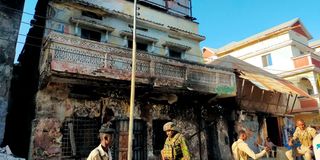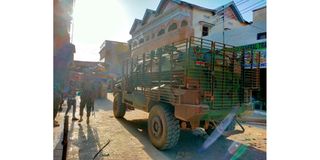Prime
Inside plans to pull regional troops out of war-torn Somalia

Shelled buildings on Pretoria Street in Kismayo town.
What you need to know:
- The African Union Transition Mission in Somalia was broken down into four phases, each taking a period of nine months with the exception of the last one that will take six.
Kenya Defence Forces’ Senior SSPR Carly Mdinyu has successfully deactivated an improvised explosive device (IED) barely a kilometre from the Sayid Mohamed Abdule Hassan International Airport at the Somalian port city of Kismayo.
With him are a three staff from the United Nations Mine Action Service (Unmas) and two soldiers from the Somalia Nation Army (SNA) who, under his tutelage, are learning how to dismantle and dispose IEDs planted by al-Shaabab terrorists.
Unlike other days though, this exercise was conducted in a controlled environment in what has slowly become the daily rote for several KDF, SNA and Unmas staff.
All sweaty and dirty, SSPR Mdinyu reveals that he has successfully trained five SNA personnel since April.
“We are training them these things alongside other military tactics so that the transition period finds them ready to take over when we will leave,” he said.
SSPR Mdinyu, alongside other 18,585 troops commissioned by the African Union to help Somalia on its path to recovery from the jaws of anarchy and insistent threat posed by al-Shaabab, should be leaving the country by December 2024.
By the time of their exit, the country’s security apparatus should be solid enough to counter the constant challenges they face in maintaining their sovereignty.
But with only two years and two months to the deadline set by the African Union Transition Mission in Somalia (Atmis), the restoration of Somalia into a fully-fledged democracy running its own affairs as envisaged by the United Nation Security Council’s Resolution 2628 (2022), could just be a pipe dream.
However, Deputy Special Representative of the Chairperson of the African Union Commission to Somalia and Deputy Head of Mission Fiona Lortan’s resolve is undaunted.
“We cannot just pack up and leave ... By securing Somalia, we are securing the countries in the region,” she said.
With the collapse of Africa Union Mission in Somalia (Amisom) that had been in operation for the past 15 years, it was apparent that the country still had a long way to go.
In addition to constant terrorist attacks as well as drought, famine, and a broken education and governance system, the saliently powerful clan system also continues to pit clansmen against their perceived enemies, effectively blocking out chances of collaboration on nation building.
That is where Atmis, a multi-dimensional mission made up of the military, police and civilians from several countries, came in, with a clear mandate by the AU Peace and Security Council Communiqué for 1068th Meeting and the UN to fully implement the Somali Transition Plan.
For the plan to work, Atmis was broken down into four phases, each taking a period of nine months with the exception of the last one that will take six.
Phase one involved the reconfiguration from Amisom to Atmis and involved troop deployment.
Phase two will see the joint shaping and clearing operations and the handing over of some operating bases to the Somali security forces.
Phase three will see the handing over of the remaining operating bases to the Somali Security Forces. The last phase will see the withdrawal and liquidation of Atmis.

A Kenya Defence Forces soldier under ATMIS guards the open field next to Sayid Mohamed Abdule Hassan International Airport in Somalia.
With soldiers from Uganda, Kenya, Burundi, Djibouti and Ethiopia, the troubled zones of Somalia were clustered into six sectors with each country being handed a sector to maintain.
Sector One (Around Mogadishu and Lower Shabelle) is controlled by Uganda; Sector Two (Middle and Lower Juba) by Kenya; Sector Three (Bakool, Bay and Gedo) by Ethiopia; Sector Four (Hiraan and Galgaduud) by Djibouti and Ethiopia; Sector Five (Middle Shabelle) by Burundi and Sector Six (Lower Juba and Lower Shabelle) by Kenya and Ethiopia.
Atmis Force Commander Lieutenant-General Deomede Ndegeya is particularly concerned by the ever-changing tactics employed by the al-Shaabab.
His deputy, Major-General William Shume, who is in charge of operations outlines challenges that the mission is facing, ranging from language barrier to limited funds, lack of proper coordination that is bogged down by tedious bureaucracy when running multiple operations and infiltration of the Somali Security Forces by the Amiyat (the al-Shaabab intelligence wing), and constant attacks on crucial towns.
Regardless, the two believe they have what it takes to counter radicalisation and violent extremism by December 24.
Of importance too, is the inclusion of police officers from Kenya, Ghana, Nigeria, Sierra Leone, Uganda and Zambia who are key in training, strategic leadership and policy guidance for the Somali police forces.
“We need to establish rule of law and police must meet internationally accepted standards of human rights. We also work with our civilian counterparts who help in educating the masses,” Senior Superintendent of Police Ndili Alex Munyau, who is the Deputy Coordinator, Police Reforms at Atmis, said.
Coordinating the training activities from Banadir (Mogadishu), officers from contributing countries have engaged police commissioners all the way to the lowest ranked officers teaching them how to handle different cases. At times, Atmis has built and equipped entire police stations.
At least nine new stations have been built since 2016. Before their intervention, most of the Somali police were not aware of the standing orders governing police work and it was not uncommon to find police stations running without the police diary (Occurrence Book).
In June, some 150 police officers were recruited after successful training on the recruitment guidelines that outlined the minimum standards of police recruits. With help from their trainers, the Somali police chiefs, through a specially formed recruitment committee identified, selected and vetted new officers to the force.
According to Atmis Chief Military Intelligence Officer, Colonel Sirat, Somalia, though relatively calm, remains unpredictable. Several deadly attacks have been recently conducted by the al-Shaabab.
For instance, on October 3, a vehicle borne IED went off in the east of Beletweyne District killing several, including senior Hirshabelle State officials.
On September 30, another attack was staged at Bassra near Ballad Town. Police Commander Brigadier General Farhan Mohamoud Aden and one journalist were killed.
On August 19, Hiyat Hotel in Wadajir District was attacked, 21 people were left dead with a massive 117 injured. On July 17, a brazen attack happened at Johwar, near the presidential palace, killing 10 and injuring 15.
The worst attack happened on March 23 when two al-Shaabab militants in Somali National Army uniform attacked Safelane Compound near Marine Market inside the Atmis Base Camp.
The two, dropped by a white Toyota Mark 2 saloon car killed two guards, injured for of Safelane’s international staff, two days later, a body believed to be that of Safelane Project Manager was found under burnt debris of a classroom.
One Somali Police Force officer later succumbed to injuries with another four being seriously injured. Atmis Forces responded and eventually put the two terrorists out of action after a one and half an hour fiery exchange.
Unknown to many, in more ways than one, the Russia-Ukraine war is affecting global UN peace keeping missions which include the Atmis operations.
Also Read: Why KDF won’t leave Somalia soon
In Somalia alone, eight helicopters have been grounded following a UN ban on aircraft donated by Russia. So serious is the situation that the Kenyan team of journalists scheduled to travel to visit the KDF in Dhobley (Sector 2) could not since the helicopters, though available, could not be used for their flight.
Plans to acquire more fighter and luggage aircraft exist, but the financial muscle to attain this goal is muzzled. Ms Lortan revealed that the only source of funding for Amisom and Atmis has been the European Union (EU) and the United Kingdom (UK).
UN has been offering logistical support with the latter offering non-weapon support to troops since the countries contributing the troops provide for the armoury and weaponry. The EU and UK have pumped at least Sh240 billion ($2 billion) to the mission over the past 15 years.
With the scheduled visit to Dhobley a failure, an emergency plan was hatched and off to Kismaayo (Sector 6) did the Kenyan deputation of scribes head to. Kismaayo’s important port operations were once bedevilled by piracy courtesy of al-Shaabab militants.
This was until it was recaptured by the Kenya Defence Forces under leadership of the late President Mwai Kibaki and former Chief of Defence Forces Julius Karangi.
At the sector’s headquarters, the Kenyan troops alongside their Ethiopian counterparts have managed to secure the only functioning airport in the region, the Sayid Mohamed Abdule Hassan International Airport.
The facility that runs an average of 12 to 15 flights per day has a single standing structure with the only tarmacked area being the runway and landing area.
Travellers are checked-in some two kilometres away at the Atmis sector headquarters and then transported to the waiting area on the landing area.
This process, though backward, is progress. Al-Shaabab’s operations in this area saw the airport’s utility atrophy to the point of near death.

Photo showing Kenya Defence Forces' B7 armoured vehicle at Pretoria Street on Kismayo town days after two buildings were razed by a huge fire.
Just next to the airport is KDF’s Second Mechanised Infantry Battalion (2 MIB) under Lieutenant Colonel Daniel Kasaine whose troops have also secured the open plains around the crucial transport hub.
Moments after arriving at the 2 MIB base, sector two’s (Dhobley) deputy sector commander, Colonel J. Maiyo, lands aboard a 500 MD attack helicopter.
Things have been far from smooth financially, he says, but slackening will see the old al-Shaabab monster rear its ugly head again and as such, the cost of war, though expensive, must be borne.
At least 100 terrorists have been put out of action since February mainly through the involvement of local communities.
This new approach is proving successful across all sectors. To gain the locals’ confidence, KDF has employed a variety of tactics including supplying food and medicine.
“We offer weapon training, combat casualty care as well as offer nursing as well as midwifery skills to both military and police officers as well as civilians willing to learn.
The Somali government is trying but they still lack facilities including military manpower, weapons and even logistical assets to facilitate their forces’ mobility,” Col Maiyo said.
A major challenge that cuts across Sector two and six is the residence of al-Shaabab alongside the fertile Juba Valley which slopes all the way from Ethiopia to Southern Somalia.
Knowing well that the Juba River is the country’s breadbasket, the extremists have turned the agricultural hub into their playground.
UN estimates that the total amount of money made by al-Shabaab from their illegal tax collection ranges between $100 million and $150 million (approximately Sh12 billion to 18 billion) annually which they use to acquire weaponry, plan for logistics and run their operations.
By recapturing the entire Juba Valley, massive damage would be inflicted on the terrorists and Colonel Maiyo is certain they will achieve this goal.
“We are now more robust, more equipped to tackle their (al-Shaabab) strongholds in our sector. We will capture the areas very soon. Operations are coming, we have no worries, with our trained soldiers, we will succeed. One victory will be our motivation to the next,” he said.
[email protected] the same 2 MIB forward operating base is the level 1 plus Hospital which though situated in a military camp, offers medical care services to the locals in Kismaayo. The Nation found Lt Col.
Dr S.M Onyango attending to three in-patients. One suffered a gunshot on his left calf, another survived an explosion blast and another one had a recurring illness and had been recently admitted to the facility.
At the heart of Kismaayo town, some 10 kilometres from the base, several locals are counting losses after a generator pumping oil from one if the stores in a two-storey building along Pretoria Street exploded in earl October.
Had it not been for the quick intervention by ATMIS troops located at the nearby base, they fear the entire street would have caught fire.
Kismaayo’s mayor, Omar Abdullahi expressed his gratitude to the troops whom he said came in handy in helping quell the fire that reduced to ashes the previous oil trading point in the dusty street that majorly deals in cosmetics, fuel and perfumes.
“I really thank the ATMIS soldiers who helped my people in preventing the fire from spreading across the entire street. They have also helped improve security here and this is something we do not take for granted,” he said.
Kismayo Central Police Commander, Warsame Ahmed, on his part, said the training they had received from their police counterparts in ATMIS has assisted them in enhancing community patrol and documenting of cases in the area.
Of importance, the locals, who have trained themselves to withstand disorientation and stay calm until their world melds itself back together, say, is the fact that the threats from the Al-Shaabab have greatly reduced thanks to the interventions by ATMIS.
They too, like their compatriots in the other sectors trade information with the troops who then act on the intelligence to counter planned attacks by the slippery extremists who are proving Houdini in the region.
It is this close working between the ATMIS troops and the Somali people that the Force Commander, Lt Gen Deomede Ndegeya, his deputy,Major General Shume and acting special AU representative Ms Lortan, believe will lead to an end of the Al-Shaabab menace.
Also, the recent setting up of Joint Operations Command Centres in all sectors has enabled the soldiers, though coming from different countries, communicate and coordinate all their operations at the touch of a button.
“At the end of the day, Somalia has to take responsibility of itself. The Somalia Transition Plan drafted majorly by the Somali government is on the driver’s seat,”Ms Lortan said.
This she said even as a silent dread rested behind her eyes. And she has her genuine reasons. The four phases are not going as planned thanks to the prolonged election period in Somalia that consumed the first four months of the first ATMIS phase.
This hitch will spill over to the next phases. With 2,000 ATMIS troops set to be withdrawn by December this year, she fears this could leave the fragile state exposed to more attacks by the Al-Shaabab.
Strict adherence to the initial plan could turn out to be a sword that could either be used to knight Somalia into statehood or slice it.
The Somali government has also already said it is not ready for the first draw down but, ATMIS cannot on its own prevent the planned move unless the UN Security Council and the AU make a decision to change the set dates.
“The (Somali) people are not loyal to the Al Shaabab but submissive due to a lot of fear and reprisals. Our plan though, is not just to leave by December 2024. If the enemy will not be beaten by then, a joint assessment by the AU, UN and the Federal Government of Somalia will be done to make a decision on what next.
Even as one leaves the arid-country whose resolve to rise above the hardships blocking its path to a fully-fledged sovereign state, one wonders, will ATMIS subscribe to the wise saying of old where one does not desert his post when the storm lashes or will they abide the other one; that a wise sailor flees the storm as it gathers.
What remains true is that for the interminable infighting to cease, more than just troops will be needed in Somalia.
A day will doubtless come when the much-needed skill and discretion will be required of the Somali government and its people who are true to the growth of nationalism and democracy.





